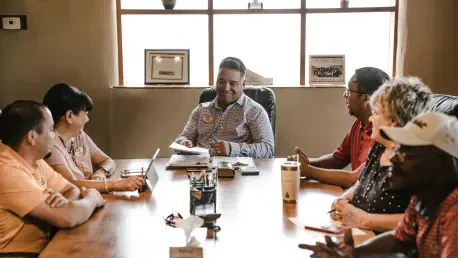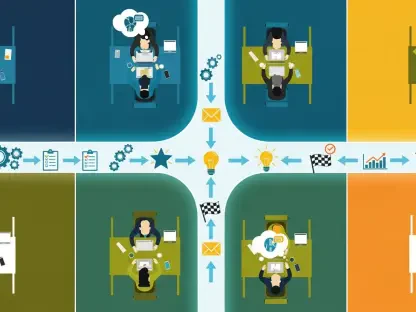In today’s competitive job market, attracting top talent is crucial for organizational success and sustainable growth. As job candidates become more discerning, they look beyond mere titles and salaries, seeking environments where they can thrive both personally and professionally. Hence, merely listing a polished job description with attractive benefits is no longer sufficient to secure dedicated professionals who can drive a company forward. This trend underscores the importance of showcasing workplace culture during interviews. Companies need to offer potential employees a genuine glimpse into their operational ethos and values, demonstrating how these translate into day-to-day work and interactions. The interview process has thus evolved into a strategic platform where firms must illustrate their admirable workplace environment and growth potential, not just articulate it. From environment tours to team introductions, how a company presents its culture during interviews plays a pivotal role in attracting the right talent. Exploring specific methods to bring an organization’s culture to life sets the stage for a meaningful connection between candidates and employers, ultimately influencing the decision-making process of high-caliber professionals.
Conduct Comprehensive Workplace Tours
Conducting a detailed tour of the workplace provides potential employees with a firsthand view of their prospective environment, doing wonders for transparency and engagement. Tours should offer insight into collaborative spaces that drive creativity and productivity, and showcase any technological investments that enhance efficiency and innovation. Showing amenities, such as relaxation zones and dedicated meeting areas, reflects a company’s commitment to employee well-being. A workplace tour isn’t just about revealing physical space; it’s an opportunity to display how these elements contribute to an engaging and effective work culture. For organizations adopting remote or hybrid work models, virtual tours using cutting-edge video technology can efficiently highlight digital collaboration tools and remote work support systems. Remote tours serve as an alternative that equally showcases a firm’s infrastructure, eliminating geographic barriers and offering a broader insight into the company’s tech-savvy side. By providing a full-fledged understanding of the workspace, employers can affirm their organizational values, ultimately convincing candidates of their compatibility with the firm’s culture and their potential role in advancing operational objectives.
Arrange Strategic Team Introductions
Strategic team introductions offer candidates the chance to observe workplace culture from a relational perspective, potentially one of the most effective tactics in the recruitment arsenal. These introductions must be well-structured yet relaxed enough to be genuine, as candidates look for authentic interactions that are indicative of the organizational culture. Meeting select team members who exemplify the company’s values and dynamics allows candidates to gauge team synergy and understand how the organization facilitates professional growth. A strategic approach to introductions ensures candidates encounter colleagues whose career journey and experiences reflect the support offered by the organization for holistic development and productivity enhancement. Such interactions can elucidate how collaboration and teamwork propel the organization forward, making prospective hires feel part of an ongoing narrative where their skills and ideas are valued. Employers who carefully curate these interactions demonstrate their willingness to integrate new members and foster a collaborative work environment that prioritizes personal and professional growth, ultimately making it easier for candidates to visualize their future within the firm.
Share Specific Growth Stories
Narrating specific growth stories within the organization paints a vivid picture of professional development opportunities that candidates crave when contemplating a job offer. Concrete examples of career advancement prove instrumental in illustrating the organization’s commitment to nurturing talent and promoting from within—a significant factor for many high-performing professionals. Employers should prepare narratives showcasing successful transitions, such as employees evolving from entry-level roles to leadership positions, achieving noteworthy milestones, or spearheading projects that contributed to the company’s success. Such stories reinforce abstract promises, demonstrating real-life scenarios where dedication and skill meet opportunity, incentivizing candidates to be part of a growth-oriented culture. Stories of professional evolution not only captivate potential hires but also instill confidence, showing that their aspirations align with the company’s trajectory. They create a relatable context that enables candidates to breach initial apprehensions, perceive the tangible paths to advancement, and foster enthusiasm for potential contributions to organizational success—all vital steps in securing talented professionals who are looking for long-term career growth.
Implement Structured Q&A Sessions with Leadership
Structured Q&A sessions with company leadership offer candidates insights into management style and transparency—a crucial element in determining alignment with organizational values. During these sessions, the balance between prepared talking points and authentic responsiveness to candidates’ inquiries is indispensable in offering a comprehensive understanding of leadership philosophies. When senior executives engage in conversations with potential hires, it signals a culture of openness and a commitment to transparent communication across the organizational hierarchy. This accessibility contradicts the notion of isolated executives, portraying them as approachable mentors invested in the firm’s future and the professional development of team members. A well-organized dialogue with leaders not only showcases the firm’s foundational principles but also fosters trust, illustrating how leadership manifests itself in everyday operations and decision-making. Such discussions reinforce a reciprocal communication ethos, promoting an environment where all voices are heard and valued, thus further endearing the organization to discerning candidates who prioritize leadership alignment in their decision-making process.
Showcase Data-Driven Achievements
Presenting data-driven achievements during interviews substantiates claims regarding workplace productivity and overall success, making the abstract tangible and reassuring candidates of what the organization can accomplish with its collective workforce. Employers should strategically share relevant metrics that highlight impactful projects, team achievements, client satisfaction scores, or efficiency improvements that align with company goals and values. Information substantiated by data provides a factual representation of how company culture influences organizational effectiveness, thus proving invaluable in establishing credibility with prospective hires. Metrics serve as touchpoints where an organization’s commitment to excellence is translated into quantifiable outcomes, offering candidates assurance of the firm’s capability and supporting its promises of success. Data-driven narratives not only validate the organization’s operational prowess but also guide candidates in imagining their role within this context, ensuring they can contribute meaningfully to the firm’s growth and success while navigating their own professional journey.









